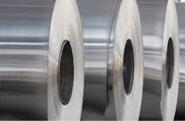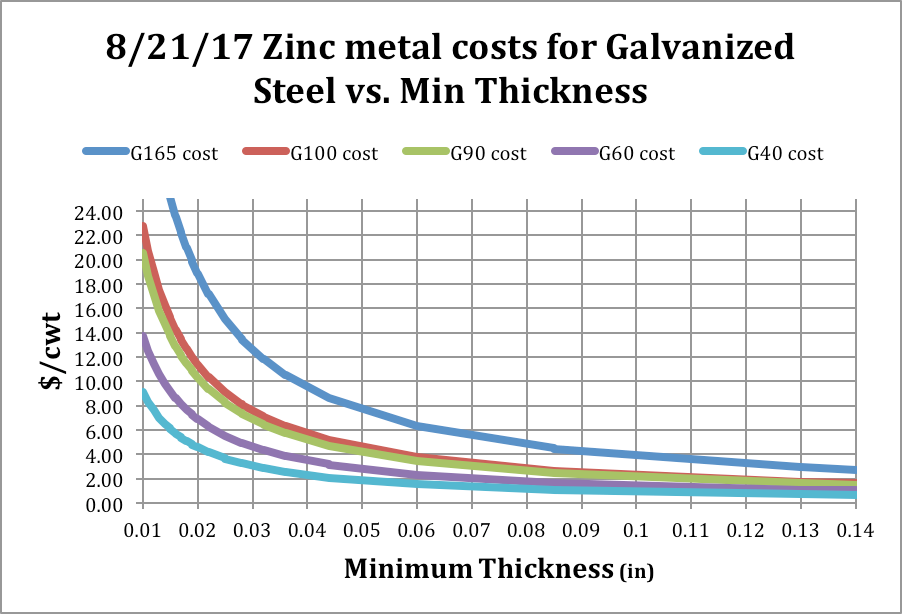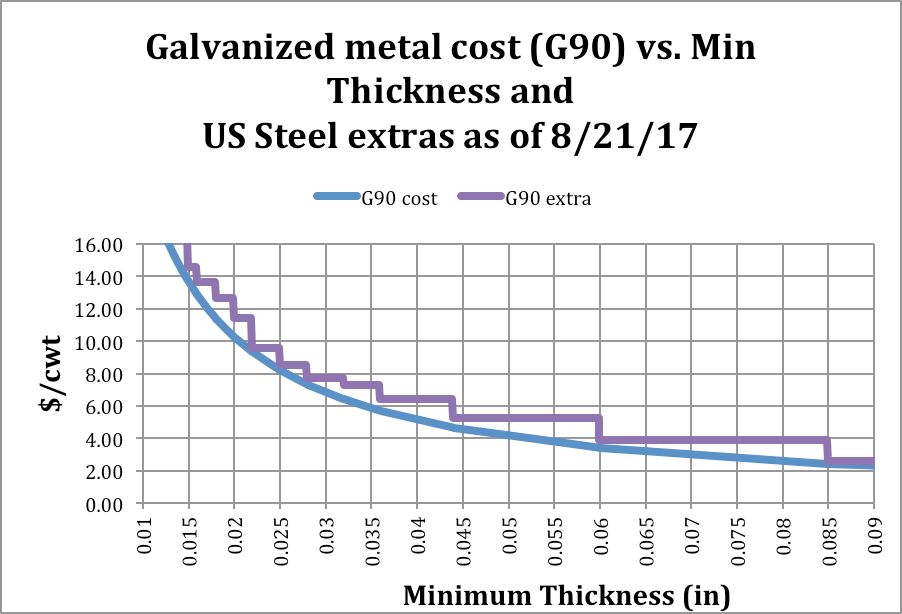SMU Data and Models

Steel Buyer’s Basics: Coating Costs
Written by Mario Briccetti
August 22, 2017
Over the last few weeks, the price of zinc has risen to over $1.41 per pound on the London Metal Exchange, and I thought it was time for an update on a series of articles I’ve written on the actual metallic cost of coating steel with zinc.
To do the calculation, I use a spreadsheet I developed to calculate the impact of zinc and aluminum prices on galvanized and Galvalume coating costs. Below is a graph of coating costs for zinc on a range of coating weights and coil thicknesses (widths do not matter). Metal costs are based on the LME Zinc index with 7.5 cents added to that for the U.S. Midwest surcharge (which covers warehousing costs). These costs only include metal prices and do not include any labor, energy or other overhead costs.
Coating costs rise as coating weight increases (of course) and also rise for thinner and thinner steel thicknesses.
The mills last adjusted their galvanized cost adders in April 2017 when the U.S. delivered price of zinc ingot was $1.24 per pound. To see if mills now need to increase their extras, I updated the following graph comparing coating costs for G90 material on thicknesses from 0.0125” to 0.045” (the smooth line) and U.S. Steel’s current galvanized adders (stair-step line) published in April 2017. (Note: different mills have various extras, but most are about the same as USX.)
As you can see, the difference between the cost of coating steel with zinc and the extra is quite small. For instance, at 0.025” minimum thickness, the difference between the mill’s cost for zinc and the price they charge is only $0.27/cwt. That $0.27/cwt must cover all the mill’s galvanized processing costs (energy, labor, depreciation, etc.) just to break even on this size.
The domestic steel mills are unlikely to change Galvalume extras even though aluminum recently jumped in price by 10 percent. That’s because the gap between metal costs and extras is much higher for Galvalume than it is for galvanized. Mills haven’t changed Galvalume extras since 2012.
Based on this comparison, I would typically predict that the mills are about to raise their galvanizing extras. However, two things may be holding them back. First, zinc metal prices are in backwardation (buying zinc for delivery in the future costs less than buying zinc for delivery today). Backwardation generally indicates that the commodity’s price is going to fall, but no one can really know that. Second, the status of the ongoing Section 232 investigation remains opaque. Mills may prefer to wait to see what happens and, if they get a favorable result, make price increases across the board all at once.
However, I really don’t know the mill’s strategy for galvanized pricing. What I do know is that zinc costs have again risen to the level where mills are starting to lose money on their galvanized coating lines. If the price of zinc rises any higher, or even stays where it is now, they will have to increase their coating extras.
I have a tool available to help you calculate and track these costs for your particular coated specification (there’s a metric version, too). It’s a spreadsheet program that handles the calculations for any thickness of galvanized, Galvalume, Galfan or ZAM. If you would like a copy, please contact me at MarioBriccetti@gmail.com or call 502-380-6163.
Mario Briccetti
Read more from Mario BriccettiLatest in SMU Data and Models

SMU survey: HR, plate lead times slip as CR extends
Hot-rolled coil and plate lead times contracted this week, with most other products remaining flat, according to SMU's most recent survey data. Cold-rolled products, however, saw lead times extend 0.1 weeks to an average of 7.5 weeks vs. two weeks earlier. Hot rolled and plate lead times both contracted 0.3 weeks from our last market check.

SMU survey: Sheet buyers find mills more willing to negotiate spot prices
Sheet steel buyers said mills are more willing to talk price on spot orders, according to our most recent survey data.

Steelmaking raw material prices mixed in April
Prices of steelmaking raw materials have moved in different directions over the last 30 days, according to Steel Market Update’s latest analysis.

March service center shipments and inventories report
Flat Rolled = 58.3 shipping days of supply Plate = 60.6 shipping days of supply Flat Rolled US service center flat-rolled steel inventories edged up in March as shipments remained low. At the end of March, service centers carried 58.3 shipping days of supply on an adjusted basis, up from 56.6 shipping days in February. […]

SMU survey: Buyers’ sentiment increases
SMU’s Steel Buyers’ Sentiment Indices both rose this week.


